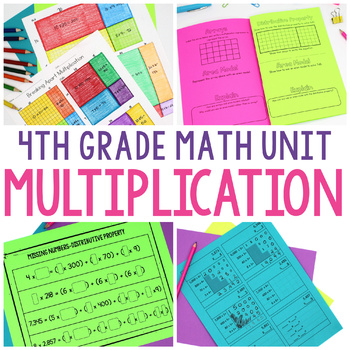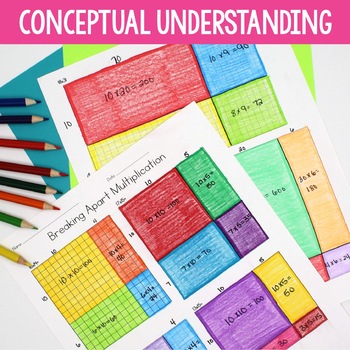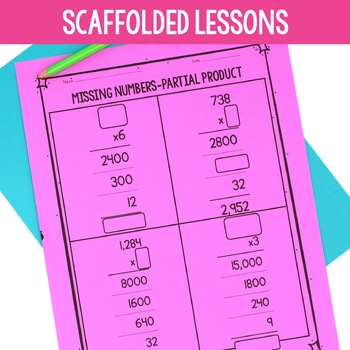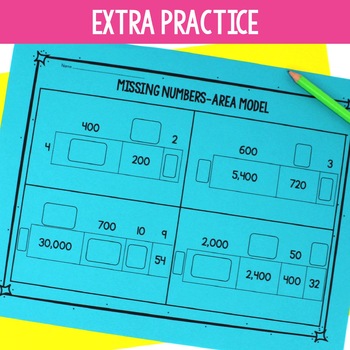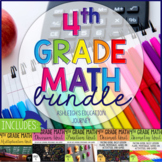Multi Digit Multiplication | Area Models | Partial Product | Factors & Multiples
- Zip
- Google Apps™

What educators are saying
Also included in
- This 4th Grade Math Bundle is a year long resource for conceptual math instruction in math workshop, guided math, or any math class. There are eight units that are each centered around a different mathematical concept: 1. Place Value and Rounding; 2. Addition and Subtraction; 3. Multiplication; 4. DPrice $65.70Original Price $73.00Save $7.30
Description
Help students to develop a conceptual understanding of multi digit multiplication with area model multiplication, partial products, factors, multiples, and multiplication as a comparison with this multiplication unit!
The multi digit multiplication resource includes five weeks of math instruction with detailed and easy to follow lesson plans. The hands-on lessons are designed to give students a solid foundation with area model multiplication, partial products, factors and multiples, prime and composite numbers, multiplication word problems, and multiplicative comparison. The other emphasis of the unit is multiplying 2-digit, 3-digit, and 4-digit numbers by 1-digit numbers, as well as multiplying 2-digit numbers by 2-digit numbers. Students use area models and partial products to solve these multi-digit problems.
In this multiplication unit you will find highly engaging and relevant math activities that can be taught in any math class.
What's Included?
- Unit at a Glance
- 30 Lesson Plans
- 20 Skill Building Worksheets
- 3 Games: Multiples Puzzle, Color the Factors, and Number Riddle Task Cards
- Answer Keys
Check out these other 4th Grade Math Units!
- Unit 1 Place Value and Rounding Unit
- Unit 2 Addition and Subtraction Unit
- Unit 3 Multiplication Unit
- Unit 4 Division Unit
- Unit 5 Fraction Unit
- Unit 6 Decimal Unit
- Unit 7 Geometry Unit
- Unit 8 Measurement Unit
Standards Taught
- 4.OA.1-Interpret a multiplication equation as a comparison, e.g., interpret 35= 5 × 7 as a statement that 35 is 5 times as many as 7 and 7 times as many as 5. Represent verbal statements of multiplicative comparisons as multiplication equations.
- 4.OA.2. Multiply or divide to solve word problems involving multiplicative comparison, e.g., by using drawings and equations with a symbol for the unknown number to represent the problem, distinguishing multiplicative comparison from additive comparison
- 4.OA.4. Find all factor pairs for a whole number in the range 1–100. Recognize that a whole number is a multiple of each of its factors. Determine whether a given whole number in the range 1–100 is a multiple of a given one-digit number. Determine whether a given whole number in the range 1–100 is prime or composite.
- 4.NBT.5. Multiply a whole number of up to four digits by a one-digit whole number, and multiply two two-digit numbers, using strategies based on place value and the properties of operations. Illustrate and explain the calculation by using equations, rectangular arrays, and/or area models.
Lessons Include:
- What are Multiples
- Multiples Booklet
- What are Factors
- Prime and Composite Numbers
- Factors and Multiples Sort
- Multiplication Situations
- Multiplication as a Comparison
- Multiplication Scavenger Hunt
- Multiply by Multiples of Ten
- Multiply by Multiples of Ten-digital
- Using the Associative Property
- Matching Distributive Property
- Distributive Property Cut & Paste
- Breaking Apart Multiplication
- Beginning Multiplication
- Using the Area Model of Multiplication
- Connect Area Models & Partial Product
- Partial Product
- Multiplication Word Problems
- Missing Numbers
- Using Area Models
- Partial Product
- Largest Product
- Multi Step Word Problems
- Multiplication Problem Solving

